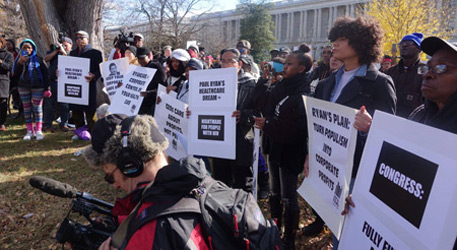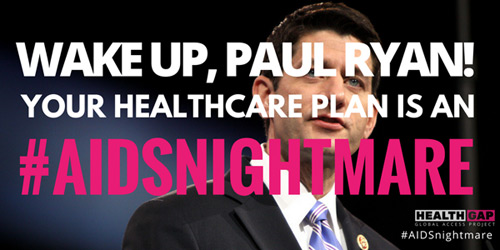The Health Global Access Project (GAP) was founded in 1998. It grew out of the HIV treatment activism movement, as U.S. based activists expanded their scope to include a fight for access to life-saving drugs in the Global North, as well as the Global South. The organization’s work around treatment access includes work on drug pricing, intellectual property rights and donor funding for the HIV response.
Health GAP’s staff is based in the United States, Uganda and Kenya, and its work is international in scope – carried out virtually or on the ground in various countries. In addition to a small team and a board of directors, the work is driven by a core steering committee. These volunteers, who have a personal and/or professional interest in the work, help to guide the decisions and directions of the organization – in fact, 30% of seats on the board are reserved for members of the committee.
Partnerships and collaborations are at the root of all Health GAP’s activities, who works with individuals and organizations to foster the exchange of knowledge and skills. The organization also provides support to activist campaigns and actions focused on local government policies and practices in the Global South, as well as the policies and practices of multinationals operating in their countries. These partnerships come to be organically, each one having its own story and path, from origin to present collaboration.
As Jamila Headley, Managing Director of Health GAP points out, “In a way, the global HIV movement has always used ICT, including listservs and conference calls.” In fact, these tools are necessary insofar as they allow one to “communicate with people who are not in the same space as you.” As new tools have emerged, new possibilities have arisen and in 2014, Health GAP started to build its use of social media more intentionally.
At the time, the organization had a fairly static website and Facebook and Twitter accounts that weren’t very active. The team didn’t include a full-time communications person, so the organization decided to secure funding to hire someone. A highly-qualified individual with political communications experience was hired, and has helped Health GAP become more strategic in its use of social media.
In a relatively short amount of time, Health GAP has harnessed social media tools and strategies as key components within its multi-faceted approach to advocacy and activism. Here are some of the lessons that the organization has learned along the way:
The work of Health GAP is based on the principle that change does not happen without people power. The organization works in close collaboration with movements of people who are living with HIV and grassroots groups to increase their ability to voice their concerns and to shape the response to the issues that affect their lives. This can be a slow process, in that not all countries and systems grant the same amount of access to civil society groups and individuals when it comes to providing input in decision-making processes. Moreover, individuals and groups have differing levels of comfort when it comes to “disrupting” the processes that they have not been invited to participate in.
In this context, the work of Health GAP is one of accompaniment. The staff work with their collaborators to explore what tools, techniques and approaches might be effective in a specific context, while providing support on the ground. Drawing from its own history as an organization, as well as lessons learned from other groups that include the Treatment Action Campaign and ACT UP, Health GAP has a range of organizing and advocacy techniques and tools to draw from, and it stays forever open to exploring new tools and new ideas.
Health GAP and the broader HIV movement have certainly been successful in making meaningful change at local, national and international levels prior to the advent of social media. However, these tools have added themselves to a pre-existing armamentarium, offering new possibilities for organization and communication. In fact, when social media and direct action are paired, this can make for a very powerful combination.
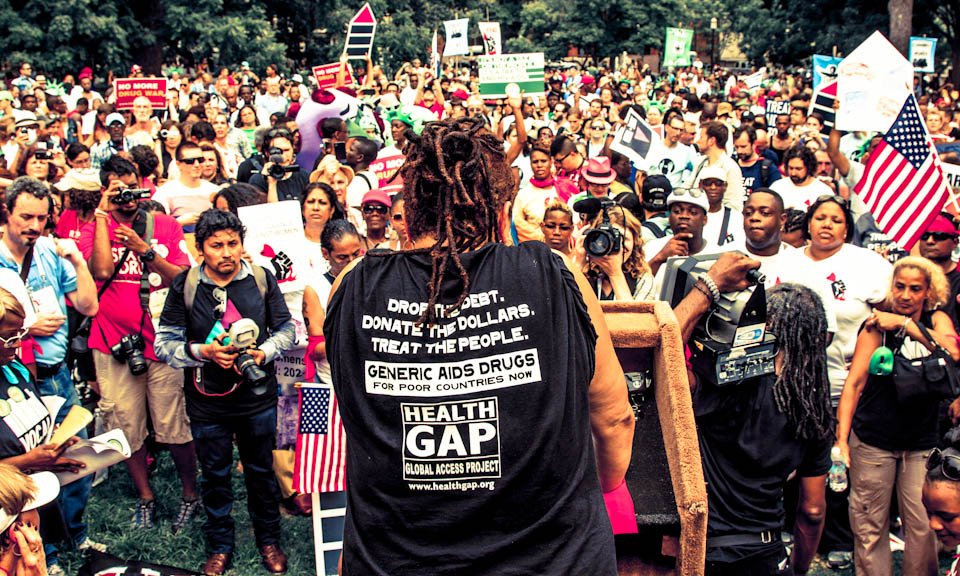
WhatsApp is an interesting new tool that has emerged on the landscape of community organizing in the last few years. A direct messaging app, it proves particularly effective for planning direct actions and coordinating multiple moving parts in a time-sensitive manner.

Global advocates gather during the High-Level Meeting on Ending AIDS in New York – June, 2016
Health GAP initiated the creation of a WhatsApp group before the United Nations’ High-Level Meeting on Ending AIDS that took place in New York in June 2016. Bringing together key decision makers, including 10 Heads of State and Government and more than 60 ministers, people living with HIV, representatives of civil society, representatives of international organizations and the private sector, scientists and researchers, the meeting offered a prime opportunity to voice some important concerns to the global HIV community. Using WhatsApp, group members were able to communicate and to coordinate concerted actions – this included arranging for all their phone alarms to go off simultaneously or starting a group coughing fit during some of the presentations.
The group was revived and expanded for the International AIDS Conference that took place in Durban in July 2016. Health GAP used WhatsApp, in addition to other tools, to work with collaborators to stage planned and improvised demonstrations, including a massive mobilization through the streets of Durban on the opening day of the conference. Organized in partnership with the Treatment Action Campaign and Section 27, “6,000 activists from South Africa and around the world came together to demand that world leaders not turn their backs on people living with HIV.”
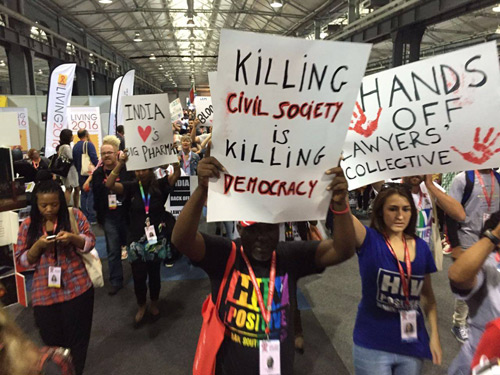 During the conference, a sub-group was also created on WhatsApp to address and mobilize around another key issue, the Indian government’s “cracking down on civil society groups and bowing to political pressure from the United States and multinational pharmaceutical companies to roll back the development of quality, affordable generic medicines for the world.” While this smaller group used WhatsApp to look after the coordination of activities, all information on planned events was relayed to the broader WhatsApp group and shared publicly via other media, including tweets and official press releases.
During the conference, a sub-group was also created on WhatsApp to address and mobilize around another key issue, the Indian government’s “cracking down on civil society groups and bowing to political pressure from the United States and multinational pharmaceutical companies to roll back the development of quality, affordable generic medicines for the world.” While this smaller group used WhatsApp to look after the coordination of activities, all information on planned events was relayed to the broader WhatsApp group and shared publicly via other media, including tweets and official press releases.
The WhatsApp group, which now counts over 256 participants and continues to grow, has been particularly useful when it comes to connecting activists and helping them to organize at large international gatherings (more activities are planned for IAS 2017, which is taking place in Paris in July). Outside of these events, the group is not quite as active, but the members still use the platform to share information and to let each other know about smaller actions taking place in their various locations across the globe.
Logistically, the WhatsApp group is fairly easy to maintain. The group counts a handful of administrators. Members are added after they complete a google form explaining who they are and their interest in joining the group. An initial set of guidelines was developed upon the creation of the group and members have been asked to comment and add to it.
On a direct messaging app, you cannot control everything that is shared and there have been some moments of tension within the group. This has included arguments about language, in that some members were posting messages in Spanish that not everyone could understand. The default has been set to English, as most members are able to communicate in this language. Health GAP encourages the members to assume ownership of the group, including regulating and monitoring one another. For the most part, this approach has proven to be smooth and successful.
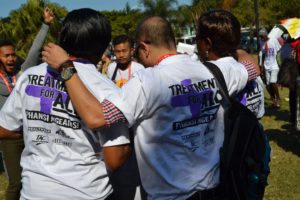
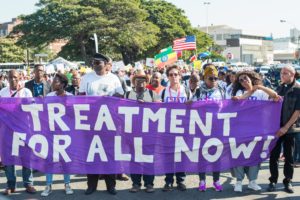

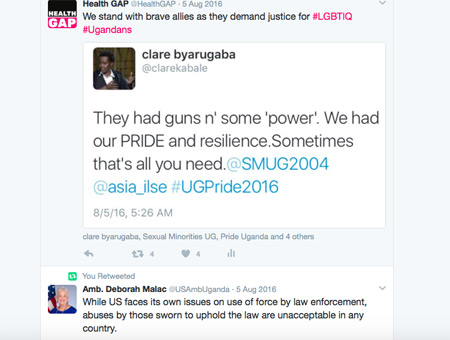 In early August 2016, the police raided an event that was taking place during the Pride celebrations in Uganda. What had initially started as a celebration of strength and love soon turned to a worrisome situation, with police abruptly shutting down the festivities and taking people away in their custody. Calls for mob violence were made for the Pride parade the next day, and these, combined with the police raid, resulted in the march being called off.
In early August 2016, the police raided an event that was taking place during the Pride celebrations in Uganda. What had initially started as a celebration of strength and love soon turned to a worrisome situation, with police abruptly shutting down the festivities and taking people away in their custody. Calls for mob violence were made for the Pride parade the next day, and these, combined with the police raid, resulted in the march being called off.
Individuals who were present in Uganda and their supporters around the world soon took to Twitter to denounce the injustices as they were happening. Using the hashtag #ugpride2016, individuals and organizations tweeted their indignation and their support, also receiving live coverage from fellow tweeters on the ground.
Health GAP was part of the conversation almost immediately, sharing the information with its followers. The organization also tweeted at and tagged people of influence, including the US ambassador to Uganda, who they then had an offline conversation with. These interventions on Twitter also helped to increase news coverage of the events as they were happening, highlighting the influence that social media have on shaping what is shared through traditional media.
Though the situation continues to be very difficult for LGBTQ+ communities and individuals in Uganda, there is comfort to be found in the notion that the eyes of the world, and of the Twittersphere, are watching and that people are ready to speak up.
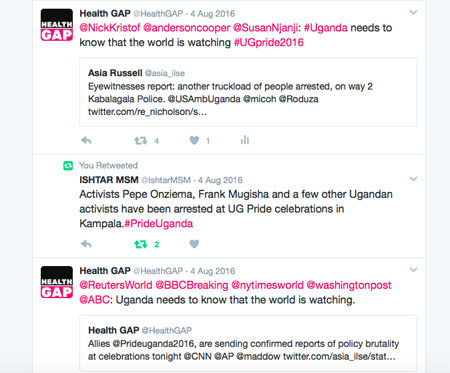
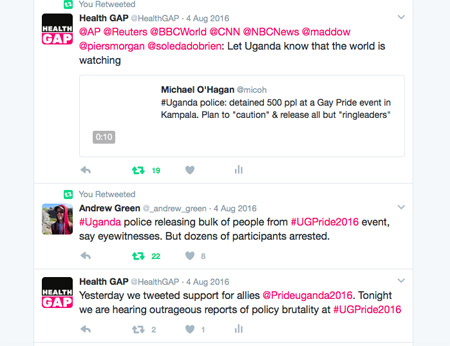
INTERESTING FACTS:
- The question of funding for social media and ICT work is always an important consideration; Health GAP has found the Open Society Foundation to be particularly supportive of this type of work.
- Health GAP houses the Student Global AIDS Campaign, a national network of students and young activists fighting to end AIDS who hold governments, corporations and civil society accountable through informed political advocacy and direct action activism.
- On World AIDS Day 2016, Health GAP held a rally and civil disobedience action in opposition to Speaker of the House Paul Ryan’s deadly healthcare proposals. Ten activists were arrested outside Speaker Ryan’s office demanding he retreat on his proposals to repeal the Affordable Care Act, privatize Medicare, drastically rollback Medicaid, and slash billions from “discretionary” funding, including global AIDS programs. While the rally was publicly announced and promoted on social media, Health GAP was careful to withhold information about the planned civil disobedience action, so as to not compromise those being arrested and thwart plans for action within the halls of Congress.
